George Raymond Johnson
George Raymond Johnson (7 February 1840 – 25 November 1898) was an architect who practiced in late 19th century Melbourne, Australia, known for designing numerous important buildings, especially town halls and theatres.
Biography
Johnson was born in Southgate, England and at age 13 began working with George Hall, Midland Railway architect. At 19 he moved to London, presumably to continue his architectural career.[1] On 24 July 1862 he married Emma Louise Wood and, nine days later, the couple embarked on a journey of emigration to Queensland.[1] In 1867, Johnson moved to Melbourne, where he produced most of his major works. In 1898, while at sea on return to Melbourne from Perth, Western Australia, Johnson contracted sepsis, and died.[2]
Architectural works
Johnson is known today for the design of a number of town halls across Victoria, notably the impressive Collingwood Town Hall, probably the most elaborate of the grand towered Second Empire style town halls that characterised the boom years of Melbourne in the 1880s, but he achieved contemporary renown for his theatres in Melbourne, Sydney and Adelaide (perhaps as many as fifteen[3]), now all demolished.[1] Johnson's greatest contemporary acclaim came from his design for the extensive northern additions to Reed & Barnes's grand 1880 Exhibition Building for the Centennial Exhibition of 1888, removed soon after the Exhibition.[2]
Johnson's major works, notably all the town halls and the theatres, were Renaissance Revival in style, and its variations including Free Classical, Italianate, Second Empire or Mannerist.[1][2] Many were designed "with bold and rich character from Johnson's mannerist palette, an idiom in which he was a master."[2] A few projects adopted different styles, such as the first building for the Hospital for Incurables, now the Austin Hospital, Heidelberg (1881, demolished), which was Venetian Gothic in character, in polychrome brick,[1] while his bluestone cottages for the Old Colonists Home in North Fitzroy (1870) were Gothic.[4]
A selection of Johnson's notable buildings are listed below. For a complete list of known works, see the database compiled by Johnson's descendant, architect Peter Johnson, included in Pride of Hotham (Hannan, 2006).[1]
| Building | Location | Year | Type | Note | ||
|---|---|---|---|---|---|---|
| Old Colonists Home | North Fitzroy | 1870 | cottages | extant | ||
| Holdsworth (Daley) Building | 376-386 Lygon Street, Carlton | 1871 | shops | rear wings removed and front sections restored 1984[5] | ||
| Prince of Wales Opera House | Bourke Street, Melbourne, Victoria, | 1872 | theatre | demolished 1900 | 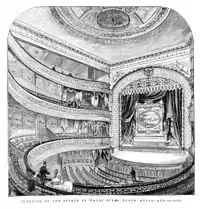 | |
| Eastern Arcade | Bourke Street, Melbourne, Victoria | 1872 | retail | modified 1894, demolished 2008[6] | 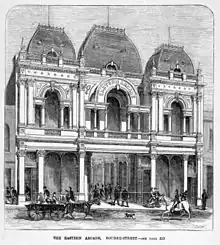 | |
| North Melbourne Town Hall | North Melbourne, Victoria | 1876 | town hall | Now Trading As Arts House | 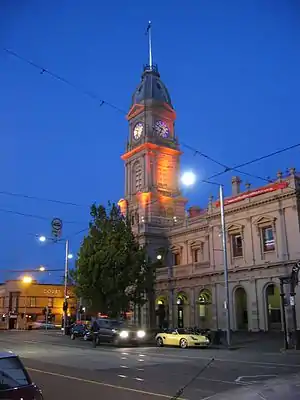 | |
| Theatre Royal, Adelaide | Hindley Street, Adelaide | 1878 | theatre | demolished 1962 | 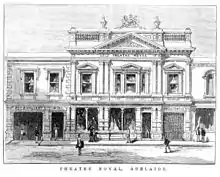 | |
| Metropolitan Meat Market | North Melbourne, Victoria | 1880 | commercial | Now a performance and events venue
Trading as Meat Market |
 | |
| Austin Hospital for Incurables | Heidelberg, Victoria | 1882 | other | demolished c1970 | 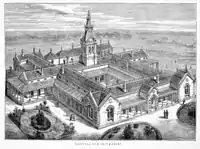 | |
| Cathedral Hotel (1882/83), | Swanston Street, north east corner of Flinders Lane, Melbourne | 1883 | hotel | demolished c1970 | ||
| Daylesford Town Hall | Daylesford, Victoria | 1882 | town hall | 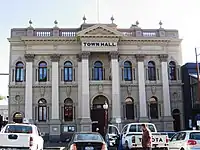 | ||
| Collingwood Town Hall | Collingwood, Victoria | 1885 | town hall | 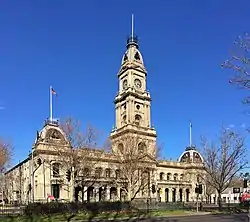 | ||
| Criterion Theatre | Cnr Pitt and Park streets, Sydney | 1886 | theatre | demolished 1935 | 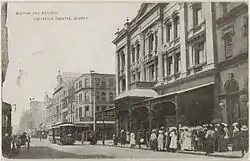 | |
| Centennial Exhibition Annexes to Exhibition Building | Carlton, Victoria | 1887 | other | demolished 1889 | 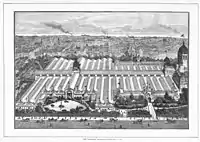 | |
| Northcote Town Hall | Northcote, Victoria | 1887 | town hall | 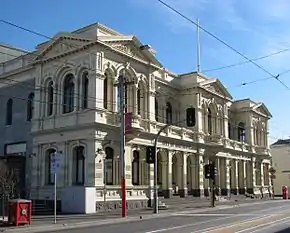 | ||
| Fitzroy Town Hall additions | Fitzroy, Victoria | 1887 | town hall | 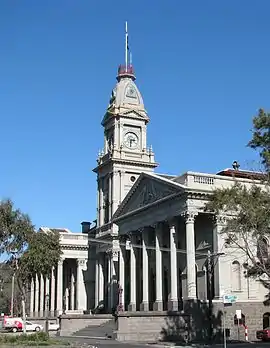 | ||
| Maryborough Town Hall | Maryborough, Victoria | 1887 | town hall | 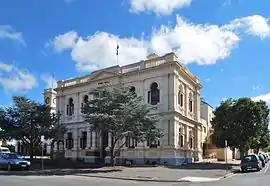 | ||
| Bijou Theatre | Bourke Street, Melbourne, Victoria | 1889 | theatre | demolished 1934 | 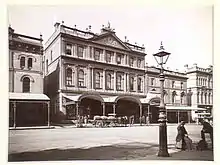 | |
| "Battle of Waterloo" Cyclorama | 55 Victoria Parade, Fitzroy | 1889 | entertainment | demolished 1927 | ||
| Kilmore Town Hall | Kilmore, Victoria | 1894 | town hall | 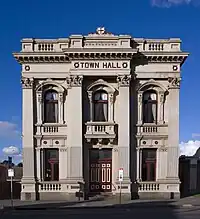 | ||
| Theatre Royal (interior only)[7] | Hay Street, Perth | 1897 | theatre | interior now shops, exterior survives |
References
- Hannan, Bill (2006). Pride of Hotham. North Melbourne: Hotham History Project. ISBN 0-9586111-7-3.
- Johnson, Peter. Johnson, George Raymond (1840–1898), Australian Dictionary of Biography, National Centre of Biography, Australian National University, accessed 16 August 2011.
- Peterson, Richard (2005). "Edgewater Towers". A Place of Sensuous Resort: Buildings of St Kilda and Their People. St Kilda Historical Society.
- "Rushall Park". Victorian Heritage Database. Retrieved 17 August 2023.
- "Holdsworth Buildings". Victorian Heritage Database. Retrieved 17 August 2023.
- Hamish Heard (10 September 2008). "Demolition anger". Melbourne Leader. Archived from the original on 5 October 2011. Retrieved 18 August 2011.
- "OPENING OF THE THEATRE ROYAL. ' THE SILVER KING.' The West Australian (Perth, WA : 1879 - 1954) - 21 Apr 1897 - p3". Trove. Retrieved 29 October 2019.